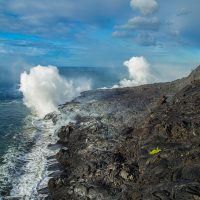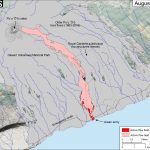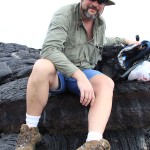Note! The contents of this posting are obsolete, there is currently no surface lava accessible on the island. When it does reach the surface again I will most likely be there, look to see an update of this article in the future!
The 61G flow reached the ocean a month ago, but only this last weekend did I get a chance to go out and see it for myself. It is quite a bit further to go than previous visits, about four and a half miles, but is it also much easier. I realized that my Getting to the Lava post is a bit outdated and a serious update is in order.



My most recent trip was my seventh trip out to the flowing lava. OK, maybe I am not yet a veteran, but these trips have taught me a lesson or two. Going onto the lava is an inherently risky proposition and one must accept that risk. With a little knowledge and preparation the risks can be mitigated. Besides, the reward is spectacular!

Where
The easiest place to get to the active flow is when it is on the coastal plain between Kalapana and the end of Chain of Craters Road in Hawai’i Volcanoes National Park. Depending on the location of the current flow you can hike in from the end of highway 130 on the Kalapana side or from the end of Chain of Craters Road in the park.
Google map of the Kalapana area
Of course, the flows can stop or change without notice. You can check for the current locations of the flows on the USGS Hawaiian Volcano Observatory website. There you can find a daily report of activity. For the last 20 years, since the eruption of Pu’u O’o, the flows have been on the plains at least part of the year, almost every year.
Hiking
It is currently 4.5 miles from the parking area at the end of the paved road to the ocean entry. While the hike on the road is easy, it is still a nine mile round trip across a barren lava field. The weather can be oppressively hot or pouring rain.
Hike or bike you will eventually leave the road and have to scramble over the rough fresh lava to reach the active areas. You must be reasonably steady on your feet and able to cross uneven surfaces.
On the coastal plain you can hike over relatively level ground where most of the old lava is pāhoehoe, not as easy to hike as a prepared trail, but not completely horrible like ʻaʻā lava either.
Biking
The fastest way to reach the flow is by bike. While no motorized vehicle is allowed on the road, at least for non-residents, you can use a mountain bike. The road is gravel, but mostly well packed and easy to traverse. There are gentle hills and downhills along the way but no serious elevation changes.

A headlight is totally necessary to avoid those hiking the road after dark. There are plenty of road signs near the ocean entry that you can use as a makeshift bike rack to lock up the bike before cutting across the new lava for viewing.
Using a bike is a quick way to cover the miles, and you will get many jealous looks from those hiking the road as you pass.
When
I prefer a predawn attack. There is some logic behind this… Hiking or biking out in the dark will be much cooler and the lava far easier to see. At night the breakouts and other activity is easier to spot, the bright golden glow visible from a mile away or more. In full sunlight the active lava is difficult to locate, you could be within yards of a breakout and be unaware. You can then take advantage of dawn light for excellent photographic conditions, the rosy glow of hot rock showing up well in low light conditions. After sunrise, you have full light for the hike back and you can usually beat the brutal heat of the afternoon on the flows.
Officially the county has announced that the lava viewing area is open from 3pm to 9pm, with the last cars allowed entry at 8:30pm. In my latest visit, and from what I am hearing from others, there is no enforcement activity beyond those hours. The number of visitors outside of those hours is quite substantial and no official presence is to be seen.
What to Carry
Carry plenty of water. I can not stress this enough! It gets hot on the black rock under a tropical Sun. At least a couple liters per person, more if the distance to be covered is greater. You will use that water much more quickly than you planned. I like to use a hydration pack with a sipping tube, it really helps to keep sipping water as you hike along.
I recommend a pair of leather gloves to wear as you cross the fresh flows. In the likely case of a slip or stumble, you can put down a hand without that hand being shredded on the glassy surface. A hat and sunscreen is also on the necessity list. The weather can vary from blazing sun to heavy rain in short order. Some sort of rain-gear is useful. I keep an old military rain poncho in my pack, it keeps me dry without being stifling in the warm tropical air.
Either going in before dawn or staying after sunset does mean crossing the flows in the dark once you leave the road. Bright flashlights and a slow and careful pace is required. I carry at least two flashlights and spare batteries. The bright LED lights that are available these days are excellent, I have a small dive light that can output nearly 1000lm. A full Moon can also assist, the moonlight making it much easier to see across larger distances thus allowing you to plan further ahead and keep your bearings once you leave the road.
Footwear
Proper footwear is a must! Sturdy boots or shoes required to traverse the fresh lava surface. The freshest lava is covered by a layer of volcanic glass shards that crunch underfoot at every step. Occasionally bits of rock that looked solid enough will give way and collapse. I have seen folks start out onto the lava in sandals or rubbah slippahs, they quickly turn back for good reason.

I have done the hike in Teva trail sandals, but only for shorter distances. Without proper side protection I really do not recommend it.
You may not want to use the new boots either. Your footwear will look a bit chewed-on after this hike as the rough lava takes its toll. The last trip out I wore my older boots, knowing they get a bit worn by the hike. halfway back the whole toe section gave way with a crack through the sole. Luckily I had a partial roll of duct tape in my pack, I was able to patch up the boot enough to continue on with little trouble.
Other Precautions
Carry a cell phone. Coverage can be spotty on the coastal plain, but there is usually a signal. If you do require assistance it is possible to make the call to get help.
This is Puna, the “interesting” side of the island. Leave nothing of value in the car, even when parking at the county viewing area.
Check out the National Park Service video embedded here. It says many of the same things, with a few other precautions about the hazards of the ocean entry. There are also some simple, but reasonably accurate animations that are quite informative.
If you do take the hike, take care and enjoy the experience. I am already planning my next trek out onto the lava. This is one of the best places in the world to witness the raw power of nature.


yes us punatics will probably take the car to LOL
Thanks for the helpful information!!